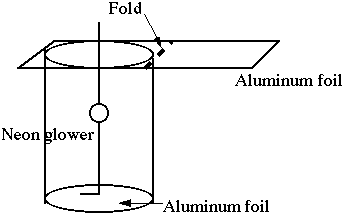Neon
Firefly
By Thomas O’Neill
o’neill@csvrgs.k12.va.us
C. Shenandoah Valley R. Governor’s School
Objectives:
- The student will demonstrate knowledge of static electricity
by constructing a simple discharge bulb.
- The student will demonstrate knowledge of static electricity
by using the Neon glower to categorize the amount of charge from
various triboelectric materials.
- The student will demonstrate knowledge of induction and
conduction by using the Neon glower to distinguish between the
phenomena.
Virginia Standards of Learning: (revised 1988)
Third grade: 3.3, 3.4, 3.5
Fourth grade: 4.4, 4.7
Sixth grade: 6.2
Eighth grade: 8.1, 8.11
Twelfth grade: 12.1, 12.3, 12.16, 12.17
Scope, Sequence and Coordination of Secondary School
Science
from The Content Core, Vol. 1 (1993). The National
Science Teachers Association. Washington, DC.
Grades 6-8 Electricity and magnetism - static charge
(pg. 102 and pg. 107-9)
Grades 9-10 Electricity and magnetism - induction (pg. 102 and
pg. 107-9)
Grades 11-12 Electricity and magnetism - Coulomb’s law and
Fields (pg. 102-3 and pg. 107-10)
Project 2061
from Benchmarks for Science Literacy (1993) American
Association for the Advancement of Science. Washington, DC.
The Nature of Science: The Scientific World View (1A pp. 5-7)
Kindergarten through Grade 2
Grades 3 through 5
The Nature of Science: Scientific Inquiry (1B pp. 10-13)
Kindergarten through Grade 2
Grades 3 through 5
Grades 6 through 8
Grades 9
The Physical Setting: Forces of Nature (4G pp.
94-97)
Kindergarten through Grade 2
Grades 3 through 5
Grades 6 through 8
Grades 9 through 12
Equipment and materials:
- Fuji clear film canister (free upon request at most
photography stores or film development centers)
- We have had success at Sprint Photo, Wal-Mart, and several
local photography stores.
- Neon glower (Radio Shack #272-1102 or 272-1101 $0.35)
- Aluminum foil
- Super glue
- Static electricity source (Silk and Teflon rod, Fur and
Ebonite, etc)
- Construction of Neon firefly
Using a pencil or any sharp point object, drill two small holes in
the film canister. One hole should be in the center of the lid and
the other in the center of the bottom. Take the Neon glower and place
it in the film canister so that one lead extends approximately 1 cm
through the bottom hole. Thread the other lead through the lid and
close the film canister. Cut two rectangular pieces of aluminum foil
which are 3 cm by 6 cm. Place one piece on the top so that the lead
pokes through one half of the foil. Glue the aluminum foil to the lid
of the canister. Bend the lead down so that it touches the aluminum
foil and fold the aluminum foil over so that the foil covers the lead
and the lid. Glue the foil in place. Trim the excess foil from the
lid so that a double layer of aluminum foil covers the top. Place the
other piece on the bottom so that the lead pokes through one half of
the foil. Glue the aluminum foil to the bottom of the canister. Bend
the lead down so that it touches the aluminum foil and fold the
aluminum foil over so that the foil covers the lead and the bottom.
Glue the foil in place. Trim the excess foil from the bottom so that
a double layer of aluminum foil covers it.
Activities:
- Using Teflon and silk, strike the silk with the Teflon rod.
Place the silk on one end of the firefly and the Teflon rod on the
other end. You should see a quick discharge of the firefly.
- Walking across a carpet on a dry day, extend the firefly
towards metal object such as doorknob or faucet. The firefly will
give a rapid flash.
- Using a static electricity generator such as a Wimshurst
machine (or a Van de Graaff generator), place the firefly between,
but not touching the electrodes. The firefly should exhibit a
steady glow.
- Using a static electricity generator such as a Wimshurst
machine (or a Van de Graaff generator), place the firefly between
the electrodes while touching one electrode. The firefly should
exhibit a series of flashes, as there is a discharge from
electrode to electrode.
Make a series of fireflies and see whether all of them will glow
or flash in the setups as in #3 and #4.

Back to the Teaching Ideas Page
Back to the Virginia Instructors of
Physics Home Page.
This page was posted on 2/26/99
|